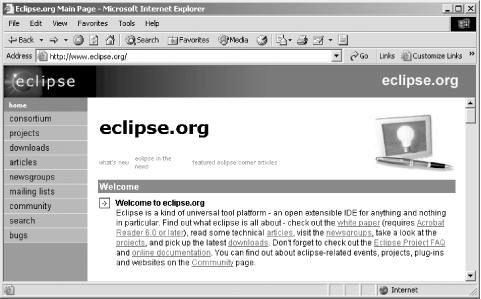|
|
< Day Day Up > |
|
1.1 Eclipse and JavaAlthough Eclipse can act as an IDE for many different languages—IDEs are available from C/C++ to Cobol—its great popularity is as a Java IDE, and it comes with Java support built-in. Eclipse refers to itself as a universal tool platform, capable of handling IDEs for many different languages, but the Java IDE that comes with Eclipse is going to be our main focus, as it is for the great majority of Eclipse users. The whole Eclipse magic is that it will take the rough edges off Java development in the way you've always imagined. The errors that would cause javac to stumble are usually handled before you even try to compile, and if there is an issue, Eclipse will suggest solutions. All you have to do is point and click—no need for serious head-scratching. If you're like most Java developers, you're going to find yourself thinking, This is great! 1.1.1 Some BackgroundEclipse is free for the downloading, like a number of other Java IDEs, but Eclipse has a serious advantage behind it: the power of IBM, which reportedly spent $40 million in the development of the IDE. The first version, Version 1.0, appeared in November 2001 and gradually became popular (although—as with any developer tool—there was a great deal of discussion of its faults). In time, Eclipse has changed and improved, and the current version, 2.1.1, is getting much praise. In fact, it's become so popular that when Version 2.1 first appeared, the servers at http://www.eclipse.org were so busy that it was almost impossible to download a copy for the first few days. Eclipse was created by IBM in a massive effort that has left Java programmers the winners. It's now an open source project, still largely under IBM's development, but part of a software consortium named eclipse.org. You can see the consortium's page, http://www.eclipse.org, in Figure 1-2. Figure 1-2. The Eclipse consortium's web page The Eclipse consortium originally consisted of IBM's subsidiary, Object Technologies International (OTI)—who developed Eclipse in the first place—along with Borland, IBM, MERANT, QNX Software Systems, Rational Software3, Red Hat, SuSE, TogetherSoft3, and Webgain2 in November 2001. Since then, the consortium has grown to more than 45 members, including Sybase, Hitachi, Oracle, Hewlett-Packard, Intel, and others. OTI is not a new player either; it's been around for quite some time, and it was responsible for the foundations behind IBM's Visual Age line of products (IBM acquired OTI in 1996). Long ago, OTI created a Java tool written in the Smalltalk language, Visual Age for Java—also called VA4J—that was well received. Eclipse itself is more or less VA4J rewritten in Java and updated—many of VA4J's idiosyncratic features have been removed in favor of more standard ones, and a great deal of development power has been added. In other words, although Eclipse itself is relatively new, it already has considerable history. The Eclipse project as a whole is divided into three subprojects:
These various subprojects are themselves divided into other subprojects—the JDT subproject, for example, is made up of the user interface (UI), core, and debug subprojects. You can learn more about these three subprojects at http://www.eclipse.org/eclipse/, and of course you'll learn a lot more about them in this book. 1.1.2 A Word About the Common Public License (CPL)Eclipse is open source software, which leaves some people uncertain about legal rights when using it. Open source software gives users open access to the software's source code and the right to modify and distribute the software themselves. If you want to modify that software, on the other hand, it's often true that open source licenses don't allow distribution of the modified software unless the end user is also given these rights (as opposed to a copyright, this is sometimes called a copyleft in open source projects). Some open source licenses insist that any software bundled with other open source software also be open source. However, the open source license that Eclipse uses, the Common Public License (CPL), is also designed to allow commercial interests. The CPL allows software bundled with open source software to be distributed under more restrictive licenses for commercial purposes. If you ever plan to modify and distribute new versions of Eclipse, you can read about the CPL at http://www.opensource.org (in particular, at http://www.opensource.org/licenses/cpl.php). Among other things, the CPL says, "this license is intended to facilitate the commercial use of the Program." That's it for the overview—let's get this show on the road. |
|
|
< Day Day Up > |
|